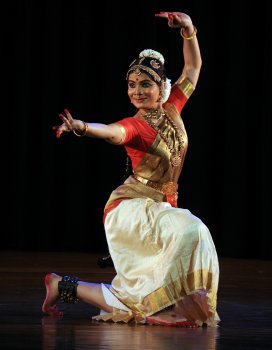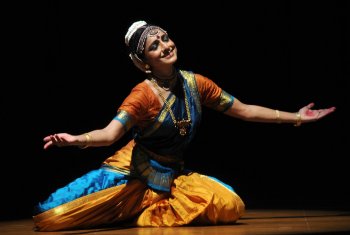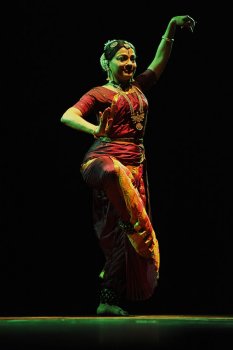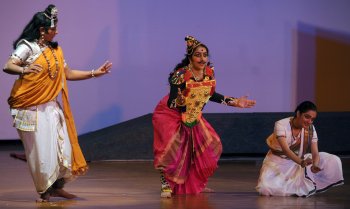
|   |

|   |
Music Academy Dance Festival: Day 3 - Veejay Sai e-mail: vs.veejaysai@gmail.com January 17, 2014 Rehearsed roundabouts The first performance for the third day morning at the Music Academy was a solo by Divya Shiva Sundar, a student of the Dhananjayans. Divya commenced her performance with an invocation to Ganesha, “Anandanartana Ganapatim,” a popular composition of Oothukadu Kavi, set to ragam Nattai and adi talam. She has a good energy about her dance and a stage presence that could get much better. However, the first thing one noticed about Divya was her aharyam. While all of it was fine, her face had been over-done, like a mask, and that was to affect her abhinayam later. For her main item, she performed the famous “Sumasayaka” varnam by Maharaja Swathi Thirunal set to Karnataka Kapi ragam and rupaka talam. This was clearly announced as being what her guru V.P. Dhananjayan has been advocating as ‘Nrityopaharam.’  Divya Shiva Sundar Photo: Thanthoni As a part of the choreography for the varnam, Divya elaborated on the Pancha Shara or the arrows of cupid using the ashtapadi “Nindati chandanam.” Her face was bereft of any expression and it will take her a long way to discover what she can do with the idea of mukhabhinayam. While Guru Shanta Dhananjayan was excellent on her nattuvangam, Divya’s dance slowed down and simmered in grace and became an exercise in displaying mechanical movements. The sancharis for “Samayam bahubaadaya….saraseeruha naabha” were completely lost in transition. While the singing of Preeti Mahesh was something worth giving a second listening to, Divya’s dance unfortunately didn’t match up to the mood the song was elevated to. Even in the second half of the varnam from “Maanini” one only got a glimpse of the highly rehearsed lines Divya performed to. Disconnect from the very essence of the composition was conspicuous. The saving grace was the wonderful flute and violin exchange Sruthi Sagar and Easwar Ramakrishnan had in between this sequence. Divya continued her performance into the famous Sarangapani padam “Mogudochi piliche” in ragam Sahana set to mishra chapu talam. The Academy’s brochure announced the composer of this padam as ‘Unknown.’ Wonder what prompted them to do so. This is one of the most famous of Sarangapani’s two hundred padams and has been performed by every possible dancer down the decades. Once again we saw repetitive gestures for every line performed. This sort of problem can be easily overcome if one takes the pains to study the language the composition is in. Knowledge of the language always aids one to interpret, play around and enhance their creativity when it comes to performing abhinayam. She followed this with the famous Dharmapuri javali “Smarasundaranguni sari evvare’ and concluded her performance with a thillana and ‘Anbesivam’ composed by Rajkumar Bharati. Divya has everything going for her and if she concentrates on her mukhabhinayam and not overdoing her aharyam, she will be a promising dancer in the years to come. The magic in her eyes When the Academy hall gets filled in anticipation of a good performance in the mid-morning slot, one wonders if the Academy made a mistake in their programming. Meenakshi Srinivasan danced to a packed hall in the morning’s second slot. Dressed in a serene blue and turmeric coloured costume, Meenakshi’s performance for the day seemed like her dedication to Krishna and an undying confession to his charming divinity.  Meenakshi Srinivasan Photo: Thanthoni Her main piece “Aatkolla Vendum Ayyane” was a varnam culled out of the larger text of Andal’s Nachiyaar Thirumozhi. Bringing in the essence of shringara bhakthi, Meenakshi’s performance also highlighted her choreographic talent. Andal’s sense of longing for her lord, her deep agony at her separation and her many dreams came forth in Meenakshi’s brilliant abhinayam. With excellent mood lighting by Harshan Thompson, one could see Meenakshi’s eyes come alive with every line she danced to. The secret fancy that Andal takes to by putting a single flower in her hair hesitantly, her sense of hope when she lifts the garland meant for the lord to place it around her neck or when she soaks herself in the fragrance of those flowers, Meenakshi’s characterization of Andal was outstanding. In the second half of the varnam, the ecstasy of Andal spotting the temple gopuram and the bliss of her eager anticipation till she finally unites with her lord, came through and through with Meenakshi’s dance. She and the character were one and not two different people. After Anita Ratnam’s ‘Andal Andal’ and Malavika Sarukkai’s ‘Maname Brindavaname’ versions of Andal, Meenakshi’s stands out as one of the best among the younger lot of dancers. Can one bring an imaginary character to life with their performance? Watching Meenakshi perform “Kuru Yadu Nandana,” one couldn’t agree more with the laws of attraction. If you’ve got it, flaunt it! Meenakshi is certainly blessed with her own style of abhinayam that leaves a mark on your memory, long after she finishes her performance. Sruthi Sagar’s melodious flute ushered us all into a world of ragam Behag. The slow romance took on a life of its own. Sitting in one place under a spotlight, the nayika came alive after her nightlong affair of lovemaking with the lord. Carefully picking a strand of hair from her body, she flirts with Krishna reminding him of what happened last night. With subtle gesturing of her eyes as she goes on to tell the lord to apply sandal paste on her bosom, Meenakshi recreated the magic of the ashtapadi in its full glory. She asks the lord to apply kajal in her eyes and once again her excellent characterization made one feel the presence of the imaginary other and her response to him. Romantic and sensuous without being direct, loud or obscene about the portrayal of the nayika, Meenakshi did an exceptional job in her abhinayam. The funny thing is the same ashtapadi was done a day earlier by Janaki, using the same singer and the same ragam. One saw a large contrast to the obviousness that Janaki chose to display and the selflessness in Meenakshi’s version. In the earlier version, we saw the dancer, in Meenakshi’s version we saw the dance. This was a good case study in understanding aesthetics of presentation and involvement. Meenakshi’s love for Krishna continued in the next item she presented. Performing to “Kunjan ban,” a Meera bhajan, once again the smartness of her choreography excelled. Beginning in a seated position, Meenakshi took us through the life of Meera’s love for her lord and got back to the same position she began. A fantastic choreographic interpretation like never before. It was only the thillana that Meenakshi did in the end that helped us in the audience to get over the spell of her performance. Meenakshi belongs to a league of highly exalted performers. She makes you forget time and space with her art. To reach this level of sublimity, it takes a lot of investment from the dancer and the rasika. Very few can help transcend this binary and show how the dancer becomes the dance itself. A Sarukkai signature One can expect just about anything in a Malavika Sarukkai performance; a traditional varnam, a pasuram, a bhajan or even an artistic response to an English poem. Over the decades of her work, Malavika has managed to inculcate many such genres into her performances with much ease and give the audiences sheer delight of an experience.  Malavika Sarukkai Photo: Siddharth Chandrasekar At the packed hall that came to witness her performance in the Music Academy, this time around it was good old mellow Malavika in her fine act. Opening her performance with ‘Sthithi- Gathi’ set to ragam Madhuwanti and adi talam, Malavika explored the ideas of movement and stillness in a cycle of three acts. This continued into her next piece titled ‘Raas.’ Set to a Ragamalika and Talamalika, this composition was set to tune by B. Seetharama Sarma taking lyrics from the Srimad Bhagawatam. The scene is that of a moonlit night in the early autumn season. All the gopis are drawn to their lord and lover Krishna. Far away in the forest, in a clear space, Krishna decides to enjoy the romance of the night with a Raas Leela. The ideas of the individual losing into the collective consciousness, the Laukika becoming the Aalaukika, the domestic becoming the abandoned were expressed in smart ways through Malavika’s choreography. It is very normal to see how gopis enact the part when they hear Krishna’s flute and get carried away with the obvious usage of hastaabhinayas. Here Malavika used the act of interspersing silence. The audience becomes a part of the narrative by witnessing the act. They are no longer spectators seated separately apart from the performance but very much a part of the entire series of events to follow. “Evam nivasatos tasmin yava keshava yuvraje,” sang Nandini Anand in a beautiful elaboration of ragam Sriranjani followed by a Malayamarutam. Malavika used the entire large space of the academy’s stage to recreate the joy of the Raas Leela. Malavika continued her performance into ‘Varanam Aayiram’ from Andal’s Nachiyaar Thirumozhi. Using the far end of the stage for her choreography as a metaphor to show the very idea of Andal being that of one who is in a different mental and philosophical league from the rest of humanity, and recreating the entire procession of musicians, dancers, devotees who throng to see the lord, Malavika’s smart usage of space was noteworthy. Using ragams like Bowli, Hindolam, Nattukurinji and Surutti, she set the mood of the piece alive. Malavika’s portrayal of the proud mother Kausalya was the highlight of her performance. In the famous bhajan “Thumak chalat Ramachandra,” she opened with a prelude before showing us how Dasharatha’s main queen embraces the idea of motherhood in her upbringing of prince Rama. After a bout of surging emotions in the hall, Malavika concluded her performance with ‘Vande Mataram’ describing the beauty of India. A rasika beside me sat weeping inconsolably as we wondered what had happened. Feeling highly intrusive about myself, I asked him the reason for such an outburst. He mentioned his mother’s tragic demise only a month ago and how both these last two pieces couldn’t stop him from thinking of his own mother. I found myself dumbstruck at this response. How does one respond to art? Drawing common threads to connect, emotionally and psychologically, if the art itself can reach out to one’s inner core, then the artist has surely done the needful. When a performance goes beyond to become an experience worth remembering, then art has succeeded. Paisa Vasool entertainment! Who would have imagined that an oft-repeated idea, especially a story from Hindu mythology has the capability to turn into a full-time piece with large amounts of entertainment? Give anything to the versatile Aniruddha (more popular as the son of legendary dancer Sudharani Raghupathy) and he will manage to churn out something interesting out of it.  Tripaada Photo: Thanthoni ‘Tripaada’ culled out of the phrase ‘Tripaadasya Amritam Divi’ from the Purusha Suktam was the launch pad of many ideas that culminated into a theatrical production. A clever mix of genres, idioms, ideas, music scores and much more, the production is one that can easily be reworked into something crisp and finer. Tripaada was the story of King Bali and Vishnu’s Vamana incarnation. While that story is well known and doesn’t need to be narrated here, one must congratulate Sudharani and her students for putting together the huge show. What did we have? A mélange of classical ragas, martial arts, folk dance motifs, traditional theatre elements and much more. One must congratulate the thought behind this huge process, though a few things could have been bettered in implementation. Last time one saw Priya Murle in such a production was in the role of lord Indira in ‘Mammudha’ performed last year at the Music Academy. This time around, she portrayed the role of King Bali. Priya is born to do theatre. She has immense talent to pull off any character she portrays with a good flair. Even Sudharani’s brief presence as lord Vishnu couldn’t match up to Priya’s acting as Bali. This production clearly belonged to her. There are always bound to be a few loose ends here and there. One was the usage of the stage space, casting and costuming. The role of Shukracharya, dressed in a rather odd costume didn’t seem to fit well. The other element about the production was the inability to utilize a stage as big as the Academy’s to the fullest. The music was also too local and wouldn’t cater to anyone outside of the regular Sabha audiences. If Aniruddha can consult a proper theatre director and rework this piece in the areas of casting, smarter usage of sets and props and rework some of the linguistic blocks that currently exist, he has in his pocket a production that could tour not just India but beyond. Yes, the production costs might be soaring with this, but so will the quality of the whole. We will all wait and watch eagerly for a newer version of this production. For now, I would call it a work in progress. Veejay Sai is a writer, editor and a culture critic. He is the official reviewer of the Madras Music Academy’s annual dance festival. |